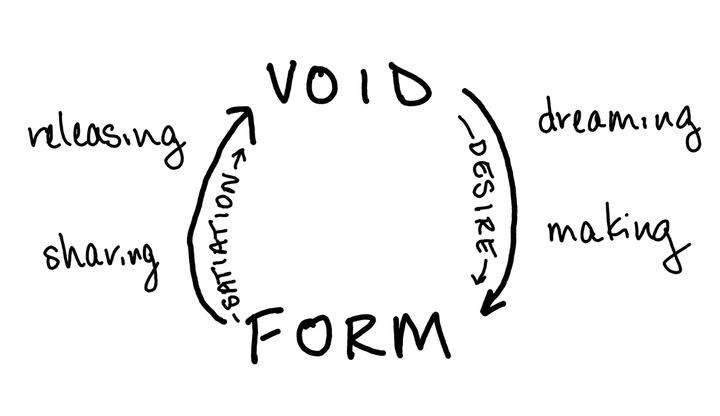Welcome to Workflows Before Rainbows
Today I watched the Steve Jobs Apple iPhone launch video after hearing Nancy Duarte’s TED talk explaining that all great presentations have the same structure: they move back and forth between the current state and the possible future, which helps the listener to make the shift to the future idea. Ending, of course, on the glorious future.
I noticed how Steve Jobs both aligned the iPhone with what came before and wholly differentiated it. In a way, there were two narratives that did this, one that placed the iPhone alongside the Mac and the iPod in Apple’s history of revolutionary inventions, another that explained the iPhone in terms of three core functions—a phone, an iPod, and an internet device, all of which could easily be understood—and then positioned the iPhone as clearly the most logical combination of these functions.
I also noticed that Jobs opened his speech saying that this was something he’d wanted to share for years.
This reminded me of another email I got today, from the company behind the Supernote. The email subject line had to do with carrots. They were letting folks know that yes, they were still really behind on a certain product launch, that “engineers are always optimistic” and essentially, that they didn’t appreciate the speculation on Reddit or elsewhere that they had been delaying the release in bad faith or otherwise trying to draw things out. The conclusion was a slightly huffy declaration that they’d learned their lesson and would never announce something in advance or be as transparent about their process. I was left with the vibe that they’d been spending too much time on their Reddit forum (I’d happily purchased the existing older version of the product three months ago, and while I saw these grumblings in the Reddit forum when I was making my purchasing choice, I hadn’t given them a second thought since then. It felt like an odd email to send all your customers, but who knows, maybe there’s some other context I’m missing.)
Also in the inbox was an announcement from Charlie Gilkey of Start Finishing and Better Team Habits that he has decided to merge his two Substacks. Previously he had managed one regarding his writing on team habits and systems, and one regarding personal productivity. He said he had done so because he wasn’t sure about combining all his personas in one place. Would the “tech” audience find his musings on personal productivity to be too “woo”?
He had split the newsletters to try to send more relevant content to everyone, but found that it was taking too much energy away from his writing, because the concepts were inherently intertwined. He addresses his own concern by saying that any business coach worth their salt would tell you to clone your best clients, the ones that like all of you.
He notes that it feels high stakes to him to combine these, because of the size of his business at this time. That a wrong move could cost people their livelihood.
I found that this was exactly what I needed to read today.
I want Workflows Before Rainbows to have all of my writing—the systems thinking, the personal essays, the rigorous examinations of metaphor and story shape. I thought I had to separate these. I thought I had to have a personal brand. Why would my healthcare colleagues want to read about metaphors and story shapes? Will anyone follow me over from my previous newsletter of lyrical personal writing about grief, body, and fertility?
But really there’s no alternative. The alternative is not to produce, to have one’s creative energy siphoned away not even by the boxes people put us in, but simply the boxes we imagine they might want to put us in, and the imagined consequences of not fitting into those boxes.
No, thank you.
One thing Steve Jobs did in his speech, which is also considered good marketing practice in general, is to make your new thing seem like a logical continuation of a process. The new features should be “chunked” together so that the impression is of something that makes perfect logical sense in line with what comes before, but with one exciting, transformative difference.
People can’t grasp all the features. People need a narrative. The narrative needs to both excite them about the potential of the change and simultaneously shrink the perceived change to a size that feels manageable.
Some say that sales is change management. Helping people get from a present to an imagined future.
Some say that everything is sales, that all of us are constantly persuading others to part with something they have in order to give us something we want.
(If you’re reading this, you’ve parted with your time to give attention to my writing. Thank you. I don’t take that for granted.)
Workflows Before Rainbows exists because I’m done parting with my time and mental energy to try to shoehorn myself into a box that I only imagine that some people want or need to see me in.
It’s all here. The personal essays. The cranky takes on public health. The obscure pieces of queer and trans history. The workplace advice.
Zoe Chance’s book, Influence is Your Superpower gives some advice for presenters. She says she starts her talks by saying:
My promise to you for this session is that you’ll leave with at least one new strategy you want to put into action immediately, and that strategy will have the potential to make a meaningful difference in your life or work.
She continues:
I’ll be sharing an assortment of strategies today and I don’t know which one will provide the “aha” moment for you, so be listening for that. When you hear it, write it down so you don’t forget. If some of what we’re talking about doesn’t connect for you, or maybe you knew it already, that’s fine—those are the strategies that are going to work for someone else. But I do invite you to listen for tools or ideas you can share with other people when you go back home or go back to work.
I’m prepared to make the same promise.
If you read Workflows Before Rainbows over time, you’ll find something that connects with you.
I’ll be sharing an assortment of writing, on an assortment of topics, and I don’t know which one will provide the “aha” moment for you, so be on the lookout for that. Do look out for what might resonate for others as well, but also be fully permissioned to not read those pieces that don’t interest you.
(And, as always, I do believe that unsubscribes are an act of curation, so go ahead and curate your inbox if you need to.)
I appreciated Gilkey’s writing today because I’d imagined that someone at that level wouldn’t have the exact same challenges and insecurities I do about merging different sides of a professional and creative life. But his note that this feels high stakes because of how far along his business is reminded me that it’s never going to get easier.
My previous writing on personal narrative and metaphor has given me the tools to make this change, just as my recent reading on marketing and communication has done so: I need to change the shape of the story.
Workflows Before Rainbows is the more holistic version of The Menstruant, the one where I don’t excise the other parts of my mind.
The one where I don’t always put personal narrative front and center so that no one can disagree with my ideas because they’re so intertwined with the personal. But also the one where rigorous professional thought can exist next to an essay about personal experience.
This feels especially important to me because trans people are often valued only for our personal narratives, not for our expertise. And if we want to be seen in our expertise, the message is to downplay or flatten our personal narrative.
Enough.
Welcome to Workflows Before Rainbows.


